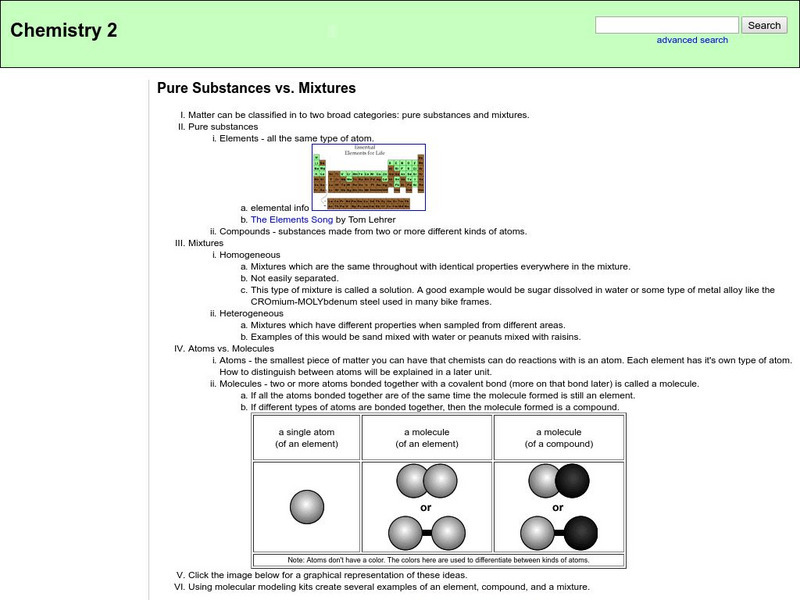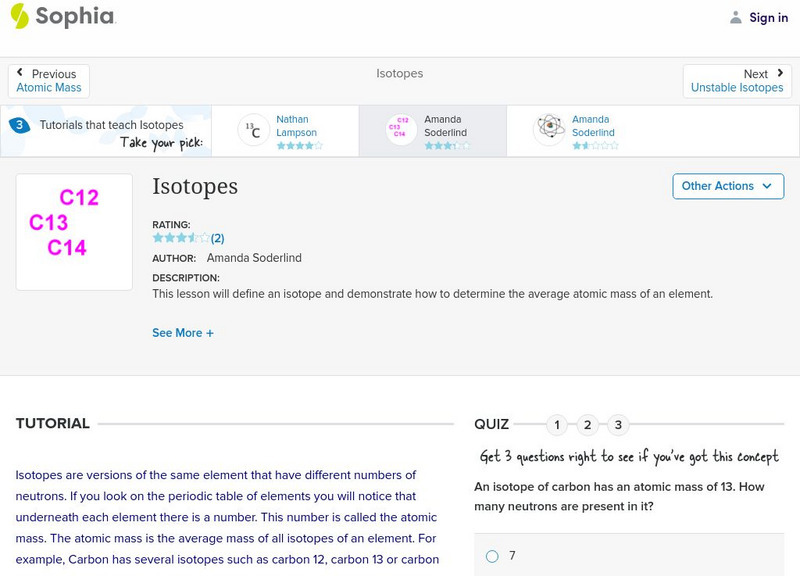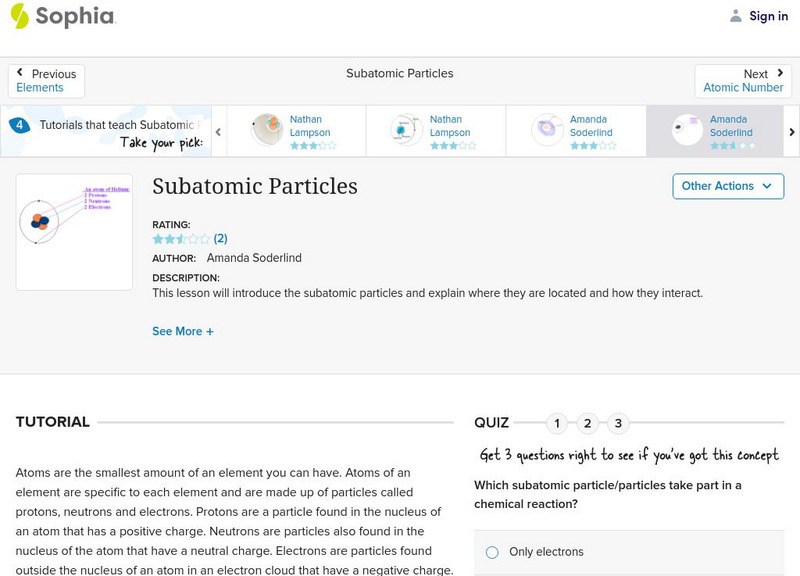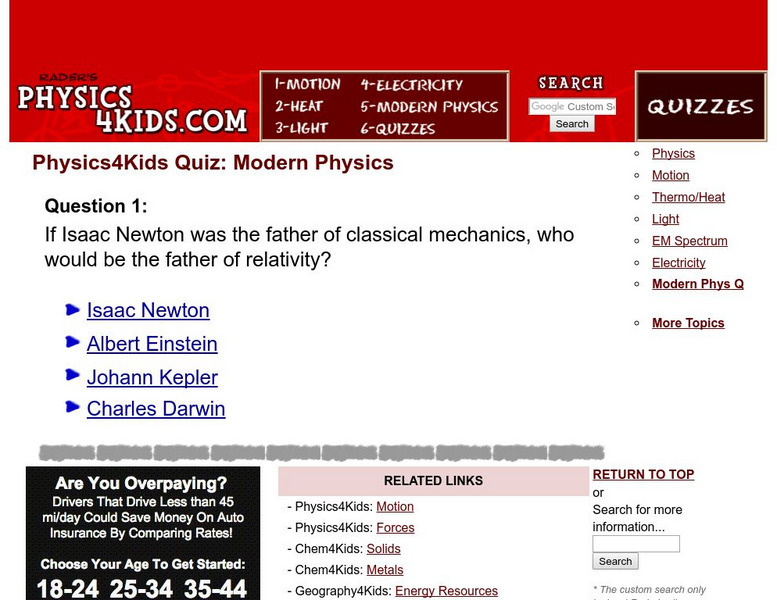Other
Chemsite: Pure Substances vs. Mixtures
An outline on the topics of pure substances and mixtures.
State University of New York
State University of New York: Paramagnetic and Diamagnetic Atoms
Make paramagnetic and diamagnetic atoms.
Able Media
On the Nature of the Universe: Study Guide
A study guide for Lucretius's work, "On the Nature of the Universe."
Clackamas Community College
Clackamas Community College: Combination Reactions
Synthesis reactions, also known as combination reactions, are explained in this chemistry tutorial. A few examples are shown. Links to practice examples and answers are provided.
Other
Popular Mechanics: Science
Popular Mechanics covers science and technology developments, including the latest trends, breakthroughs, background, analysis and information in science today. Updated every 20 minutes.
Sophia Learning
Sophia: Isotopes: Lesson 9
This lesson will define an isotope and explain what happens if the number of neutrons in an atom changes. It is 9 of 9 in the series titled "Isotopes."
Sophia Learning
Sophia: Isotopes: Lesson 1
This lesson will define an isotope and explain what happens if the number of neutrons in an atom changes. It is 1 of 9 in the series titled "Isotopes."
Sophia Learning
Sophia: Isotopes: Lesson 2
This lesson will define an isotope and demonstrate how to determine the average atomic mass of an element. It is 2 of 9 in the series titled "Isotopes."
Sophia Learning
Sophia: Isotopes: Lesson 8
This lesson will define an isotope and demonstrate how to determine the average atomic mass of an element. It is 8 of 9 in the series titled "Isotopes."
Sophia Learning
Sophia: Isotopes: Lesson 7
This lesson will introduce isotopes, and explain how they differ from other elements. It will also show that some isotopes are unstable and emit particles and/or radiation. It is 7 of 9 in the series titled "Isotopes."
Sophia Learning
Sophia: Models of the Atom: Lesson 2
Describe how the model of the atom advanced as scientific knowledge increased. This lesson is 2 of 3 in the series titled "Models of the Atom."
Sophia Learning
Sophia: Models of the Atom: Lesson 1
Describe how the model of the atom advanced as scientific knowledge increased. This lesson is 1 of 3 in the series titled "Models of the Atom."
Sophia Learning
Sophia: Subatomic Particles: Lesson 3
This lesson will introduce the subatomic particles and explain where they are located and how they interact. It is 3 of 7 in the series titled "Subatomic Particles."
Sophia Learning
Sophia: Subatomic Particles: Lesson 4
This lesson will introduce the subatomic particles and explain where they are located and how they interact. It is 4 of 7 in the series titled "Subatomic Particles."
Sophia Learning
Sophia: Subatomic Particles: Lesson 6
This lesson will introduce the subatomic particles and explain where they are located and how they interact. It is 6 of 7 in the series titled "Subatomic Particles."
Sophia Learning
Sophia: Subatomic Particles: Lesson 7
This lesson will introduce the subatomic particles and explain where they are located and how they interact. It is 7 of 7 in the series titled "Subatomic Particles."
Sophia Learning
Sophia: Subatomic Particles: Lesson 5
Describe the difference between the subatomic particles, including their masses, locations, and charges. This lesson is 5 of 7 in the series titled "Subatomic Particles."
Sophia Learning
Sophia: The Atom: Lesson 2
This lesson will illustrate that an atom is mostly empty space and has a positively charged, massive core (containing both protons and neutrons called the nucleus) surrounded by negatively charged electrons. It is 2 of 3 in the series...
Ducksters
Ducksters: Science for Kids: The Atom
Kids learn more about the science of the atom. Electrons, neutrons, and protons make up the smallest bits of matter.
Physics4kids
Physics 4 Kids: Modern Physics Quiz
Take this ten question multiple choice quiz on modern physics
Sophia Learning
Sophia: Atomic Radius: Lesson 2
This lesson will define atomic radius. It is 2 of 3 in the series titled "Atomic Radius."
Sophia Learning
Sophia: Atoms: Lesson 3
This lesson will provide an understanding of the basic chemistry of atoms. It is 3 of 5 in the series titled "Atoms."
Sophia Learning
Sophia: Atoms: Lesson 4
This lesson will provide an understanding of the basic chemistry of atoms. It is 4 of 5 in the series titled "Atoms."
Sophia Learning
Sophia: Atoms: Lesson 5
This lesson will provide an understanding of the basic chemistry of atoms. It is 5 of 5 in the series titled "Atoms."
























